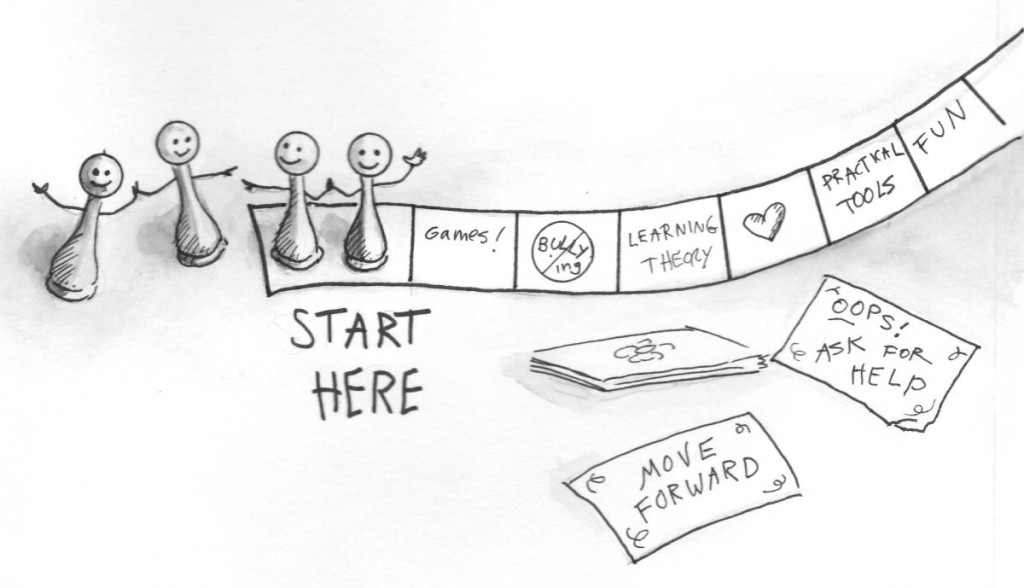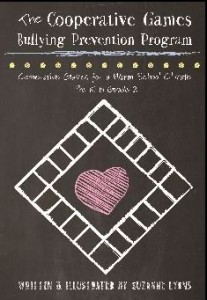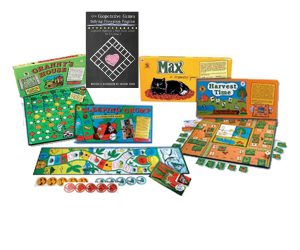
Have you heard about cooperative games? Cooperative games are games based on cooperation rather than competition. There are cooperative games of all kinds for all ages and settings. Cooperative games range from board games to circle games to PE games to digital games and more. They are all based on the principle that it can be just as much fun—well, actually more fun—to play with each other than against each other!
While competitive games emphasize individual achievement (as measured by being “better†than others), cooperative games emphasize the joy and productivity that come from working together to achieve a group goal. A well-designed cooperative game assures that players will experience the heart-felt happiness that comes from being included in a safe and supportive community.  Also, a good cooperative game assures that players will practice and value pro-social skills such as sharing, encouraging one another, contributing, and giving and taking. Further, by its very nature, a good cooperative game will clearly demonstrate that cooperating with others is practical and productive. That is, game participants discover through direct personal experience that “we’re better togetherâ€, that “many hands make light work†and “many heads are better than one.â€
Thus, well-designed cooperative games provide rich opportunities for experiential learning. They teach a valuable, pro-social lesson about the benefits of collaboration and they do it in a fun and natural way through direct personal experience.

Cooperative Games in Education
Do cooperative games have a role in education? It is easy to see that they do. As described above, cooperative games motivate players to want to cooperate plus they teach the skills needed to cooperate and they help players recognize the value in cooperation versus constant competition. The desire and ability to cooperate with one’s peers has manifold applications in education as all teachers know. So cooperative games should rightfully be part of every teacher’s “bag of tricksâ€.
For example, consider cooperative learning. Cooperative learning is essential pedagogy because it improves educational outcomes, yet its effectiveness hinges on students’ willingness and ability to work together. By introducing students to cooperative games, which naturally and effortlessly teach cooperation, the teacher primes students for success in cooperative learning.
Thus cooperative games are a sensible and smart way teachers can prepare kids for wonderful cooperative learning, group work, and collaborative project-based learning experiences.

Besides paving the way for formal cooperative learning strategies, cooperative games can also be used to teach academic subjects. More and more educational cooperative games are being developed for classroom learning these days, as the concept of cooperative games is beginning to catch on at a large scale. Educational cooperative games combine the pedagogical power of play with the advantages of learning in small groups; thus they tap two major approaches to teaching and learning. With educational cooperative games, students can learn language, math, science or other academic content at the same time that they practice cooperating. (See CooperativeGames.com at https://cooperativegames.com/ for free classroom-ready games as well as games for purchase. Note that CooperativeGames.com is a general resource for educators looking for background, information, and professional development related to cooperative play.   CooperativeGames.com is a small business owned and operated by Suzanne Lyons, MA, MA, former classroom teacher and author of this article.)
The essential role of play in learning is well-documented. For young children especially, play is the primary activity by which learning takes place. Plato said over two thousand years ago: “Do not keep children to their studies by compulsion but by play.†Cooperative games are thus important for teachers to know about simply because play is so important in learning and cooperative games use the power of play. And this is in addition to all the benefits related to cooperation!
But we are not finished yet in our summary of the benefits of cooperative games in education. Another reason that cooperative games belong in every teacher’s tool kit is that they support the broad aims of social-and-emotional learning (SEL). SEL is increasingly recognized as essential education, necessary for the development of the whole child. According to Maurice Elias, director of Rutgers

University’s Social and Emotional Learning Lab, SEL is the process through which we learn to recognize and manage emotions, care about others, make good decisions, behave ethically and responsibly, and avoid negative behaviors. SEL is the needed complement to academic content learning, because students need more than academic information to grow into happy, healthy, responsible adults successful in work and relationships. Clearly, cooperative games, which teach children how and why to get along together, help students build many underlying social-and-emotional competencies.
Besides preparing students for cooperative learning, teaching subject area knowledge, and building social-and-emotional competency, cooperative games relate to other areas of education, ranging from sustainability to special education. Indeed the applications of cooperative games to education are too many to discuss in a single blog post. You can check CooperativeGames.com for more extensive discussion.
However, this introduction to cooperative games in education would be utterly incomplete without discussing one more benefit: Cooperative games literally reduce aggressive behavior both during game play and afterwards too. This fact has been demonstrated in independent University research. (See “Cooperative Games: A Way to Modify Aggressive and Cooperative Behaviors in Young Children†by April K. Bay-Hinitz et al. in The Journal of Applied Behavior Analysis, 1994.) The ability of cooperative games to not only increase pro-social skills but also reduce aggression has important implications for school climate.
More to the point, because playing cooperative games reduces aggression, cooperative games should be utilized on a wide scale—in every classroom and at different age levels—to prevent bullying.
Cooperative Games and Bullying
Bullying is a cruel torment which is all too common. Bullying produces moments of knife-sharp suffering during the school day and it can leave dull, aching pain that lasts a lifetime too. Kids who are victims of bullying are five times more likely to be depressed compared to their peers. Kids who bully suffer as well. Bullies are at high risk for serious negative consequences including social isolation, poor academic performance and later criminal behavior. Indeed nearly 60 percent of boys classified as bullies in grades six through nine were convicted of at least one crime by the age of 24.
Naturally, teachers, parents, and government agencies are alarmed about bullying. Teachers understand that they cannot ignore the potential for bullying to disrupt the classroom and undermine learning. What to do?

A go-to source for information is StopBullying.gov, the Federal Government’s main information outlet on the subject. According to StopBullying.gov, “the easiest way to address bullying is to stop it before it starts.†In other words, bullying prevention is the most efficient way to respond
to the problem. Of course, teachers, administrators, and even peers need training in how to respond to full-blown incidents of physical, verbal, and social bullying. However, the important point is that prevention matters as well, and is indeed the most efficient way to address the bullying crisis.
At StopBullying.gov, the section Prevent Bullying offers a handful of guidelines to stop bullying before it starts. Among them, it directs school personnel to “build a safe environment†by reinforcing “positive social interactions and inclusiveness.†You can surely see that positive social interactions and inclusiveness are indeed what cooperative games are all about! Using cooperative games to protect and improve school climate is a sensible first line of defense against the meanness, aggression, domination, and exclusivity that lead to bullying. Especially when introduced early, these games have great promise.
The Cooperative Games Bullying Prevention ProgramÂ
The field of cooperative games is growing by leaps and bounds. The first time the term “cooperative game†appears in the literature is in a short pamphlet published in 1950 by Education professor and peace researcher Theo Lentz along with his co-author Ruth Cornelius, who was a first-grade teacher. Though this work was not well-circulated, the concept of cooperative games as an alternative to competitive games was first articulated by Lentz and Cornelius. It has seeped slowly through the culture and begun to bloom in diverse forms. Kinesiology professor and Olympic coach Terry Orlick pioneered the use of active cooperative games in the 1970’s through his many excellent books. Jim Deacove was the pioneer of cooperative board games, which he began to produce through his small company Family Pastimes in the 1970’s. He is still at it today!
Many cooperative game designers, inspired by these early pioneers, have followed over the past decade or so.
What has been lacking until now however is awareness of the strong pedagogical rationale for using cooperative games in education. This article seeks to address that gap. So thank you for reading it and please share if you agree that cooperative games are a pedagogical idea whose time has come! As this article hopefully indicates, there are many robust reasons that cooperative games should be used in education, not the least of which is that they can prevent bullying. It is time we educators discover and share the many benefits of playing together!

Further, if you are a teacher or parent responsible for the education of very young children, a resource for using cooperative games to prevent bullying is now available to you. The Cooperative Games Bullying Prevention Program, published in 2015, gives you all the practical knowledge and tools necessary to use this approach. This is the first bullying prevention program based explicitly on cooperative games. The core games used in The Cooperative Games Bullying Prevention Program are the very games that were tested in the 1994 University of Nevada study on cooperative games and shown to work. Thus The Cooperative Games Bullying Prevention Program is a solid, research-based approach to preventing bullying with data to back it up. It is also easy to implement, inexpensive, and of course fun! To find out more or purchase the program visit CooperativeGames.com https://cooperativegames.com/.

Finally, to make this all a bit more concrete, here is one of the research-tested, active cooperative games featured in The Cooperative Games Bullying Prevention Program. Give it a try and have some fun! And while your students wiggle and giggle without a care in the world, know that in fact you are bringing them this joyous opportunity because you indeed care so much about the world. Thank you. May the peaceful power of cooperative play be with you and yours!
 XOXOXOXOXOXOXOXXOXOXOXOXOXOXOXOXOXOXOXOXOXOXOXOXXOOXXOXOXOXOXO
 Half a Heart Â
Materials: Red construction paper or cardboard hearts, cut in half; make these yourself or use Valentine’s Day hearts
Number of Players: Any
Object of the Game: To find the friend with the missing half of one’s heart
Skills: Cooperation; Large motor skills; Communication; Math; Critical thinking
Game Category: Classroom game
To Play: In advance, prepare the hearts. You will need half as many hearts as you have children playing the game. On one half of each heart, write a number and on the other half, draw that number of circles (or use a different shape or picture besides circles if you like, for example, smiley faces.) Cut the hearts in half so one side has the number and the other half has the picture of the circles. Give each child half a heart. Ask the children to skip around the room while you play music. Now, stop the music. Ask each child to match his heart-half with its counterpart. After everyone has found their partner by matching numbers and shapes, have the children trade their halves for a different number. Start the music again, ask the kids to skip around, and find a new partner by making their half hearts whole.
